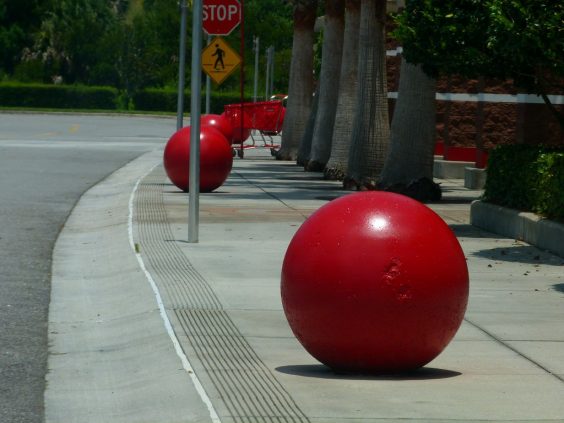
When a New Jersey mother sued Target after her son climbed on and fell off one of those big red concrete balls outside the store, cynics might have assumed the case would end up getting thrown out of court.
Turns out they were right. But they probably couldn’t have predicted it would take four years for it to happen.
A federal judge has ruled in favor of Target, in a case that earned some sympathy – but mostly the ire – of parents everywhere.
It all started back in 2015, when Venus Costello’s 5-year-old son injured himself while playing outside a Target store in Jersey City, New Jersey. Several months later, in early 2016, she sued. The boy had been “playing on and around the large red balls/objects located at the entrance and was caused to fall to the ground,” the lawsuit read, in conspicuously passive language (“was caused to fall”) that sought to hold Target liable. Costello said her son suffered serious injuries to his arm that required surgery, “due to the negligence and carelessness” of Target.
The concrete balls, which are meant to keep cars from driving up onto the curb, “attract children to play” on them, the lawsuit went on. Target should have known this, Costello argued, and was therefore “negligent in failing to design such large red balls/objects that would protect children who are unable to appreciate the risk posed by such large red balls/objects in front of a large consumer retail store that attracts and solicits not only adults but children.”
Target refused to settle the case, and Costello refused to drop it. So the dispute worked its way through the legal system, from motions, to depositions, to the introduction of evidence, to expert testimony, finally ending with the judge’s ruling, which came down last month. He granted Target’s motion for summary judgment, absolving Target of negligence, and dismissing Costello’s claims for damages of up to $1.6 million.
“There is no evidence that the bollard was improperly installed, that it had a defect, that it was dangerously slippery, or that it was defectively designed. Nor is there a contention that it violated any codes or standards,” U.S. District Judge Kevin McNulty wrote in his opinion.
The accident occurred when the boy and his aunt were waiting outside the store for a ride home. Surveillance video as described by McNulty showed the boy “climbing on and off one of the bollards” for a total of 18 minutes. “At various points, he is climbing onto one of the bollards, standing on it, lying across it, kneeling on it, and jumping off of it,” as the boy’s aunt looked on. Eventually, the aunt said, she “turned away for 15 seconds to answer a phone call… then heard him screaming” after he fell off.
Target held the boy’s aunt responsible, and filed a separate complaint against her. But Costello’s attorneys presented expert testimony from a professional psychologist/physicist/engineer who asserted that “the large, red balls decorating the entrance to the Target store were an attraction to children” that “could have been replaced by alternative designs that would be less attractive to children and would not pose a hazard to children.”
But the judge dismissed the argument that by installing bright, cheerful spheres instead of more utilitarian posts or guardrails, Target negligently made them attractive and irresistible to children. “True, it was spherical,” McNulty said of the ball on which Costello’s son was injured, “but everything has to have some shape, and there is no evidence that this shape was more dangerous than, say, a cube or some sort of stanchion.” In the end, he said, “there is no evidence to support a finding that Target was negligent simply by installing red bollards, which were properly maintained, but which might appeal to children because of their shape and color.”
Target’s director of construction testified that the balls serve a purpose, and are not meant to be decorative playthings. The balls “are visual cues to separate the sidewalk from traffic and act as a barrier between pedestrians walking on the sidewalk and cars driving in the road or parking lot,” he explained, noting that he knew of no other accidents or lawsuits resulting from people playing on the barriers.
Back when this story first appeared on Coupons in the News, commenters were universally unsympathetic to Costello’s plight. “Accidents happen all the time – just because you weren’t watching doesn’t mean you get to sue someone else,” one commenter wrote. “Supervise your children. It is not Target’s fault you can’t watch your kid,” another commented. “The front of the store isn’t a playground,” another reader offered.
“No one could fail to sympathize with an injured child,” McNulty concluded in his ruling. But Costello’s claims, he declared, “fail for obviousness. A sphere is not flat; cement is not soft; children climb on things, particularly if permitted to do so by caregivers. The danger of falling should be obvious, perhaps even to a child, but certainly to the adult caring for him.”
So Costello, and her son, have now learned an expensive lesson. The next time he wants to play with a big red ball – better make sure it’s not made of concrete.
Image source: Rusty Clark ~ 100K Photos











Pingback: The real reason Target always has those red spheres out - inula - Breaking News, Latest News and Videos